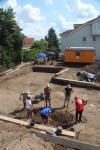 An educational dig by the Goethe University Institute of Archaeology in the city of Gernsheim on the east bank of the Rhine in Hesse, Germany, has unearthed the remains of a Roman fort. Supported by professional archaeologists from the university and Hessian State Office for the Preservation of Historical Monuments, 15 students spent five weeks excavating a small double lot in the middle of a residential neighborhood that was one of the last pieces of undeveloped property in the town. They found the first evidence of a late 1st century, early 2nd century fort.
An educational dig by the Goethe University Institute of Archaeology in the city of Gernsheim on the east bank of the Rhine in Hesse, Germany, has unearthed the remains of a Roman fort. Supported by professional archaeologists from the university and Hessian State Office for the Preservation of Historical Monuments, 15 students spent five weeks excavating a small double lot in the middle of a residential neighborhood that was one of the last pieces of undeveloped property in the town. They found the first evidence of a late 1st century, early 2nd century fort.
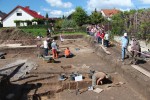 Although Roman artifacts have been discovered in Gernsheim since the 19th century, construction exploded in the 20th century leaving few sites unmolested for a proper excavation. Archaeologists weren’t even certain what kind of Roman settlement was on the site. The artifacts indicated that there was at least a vicus, a small village, in Gernsheim, which often served as the civilian settlement for the families and support staff of a military fort. Actual physical remains proving the presence of a fort had yet to be discovered.
Although Roman artifacts have been discovered in Gernsheim since the 19th century, construction exploded in the 20th century leaving few sites unmolested for a proper excavation. Archaeologists weren’t even certain what kind of Roman settlement was on the site. The artifacts indicated that there was at least a vicus, a small village, in Gernsheim, which often served as the civilian settlement for the families and support staff of a military fort. Actual physical remains proving the presence of a fort had yet to be discovered.
 The student dig hit paydirt. They found two V-shaped trenches (fossae) used in Roman fort construction as obstacles to approach and the base of ramparts formed by the dug-up soil. They also found postholes from one of the wooden watchtowers placed along the fort walls, and a few stones from the lowest layer of a foundation that once supported a structure pillaged in the post-Roman period for its masonry.
The student dig hit paydirt. They found two V-shaped trenches (fossae) used in Roman fort construction as obstacles to approach and the base of ramparts formed by the dug-up soil. They also found postholes from one of the wooden watchtowers placed along the fort walls, and a few stones from the lowest layer of a foundation that once supported a structure pillaged in the post-Roman period for its masonry.
The trenches turned out to be a motherlode not just because they’re evidence of the fort, but because of what they contained.
An unusually large number of finds were made. This is because the Roman troops dismantled the fort and filled in the ditches when they left. In the process they disposed of a lot of waste, especially in the inner ditch. “A bonanza for us,” according to Prof. Dr. Hans-Markus von Kaenel from the Goethe University Institute of Archaeology. “We filled box after box with shards of fine, coarse and transport ceramics; dating them will allow us to determine when the fort was abandoned with greater accuracy than was possible before.”
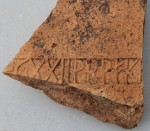 One of the artifacts recovered was nothing short of a struck of luck: it’s a brick fragment stamped with the name and number of a legion: Legio XXII Primigenia Pia Fidelis, an elite legion named after and dedicated to the goddess of fortune, Fortuna Primigenia. Finding an artifact that announces the precise legion that once occupied the fort seems like Primigenia is still looking out for her guys.
One of the artifacts recovered was nothing short of a struck of luck: it’s a brick fragment stamped with the name and number of a legion: Legio XXII Primigenia Pia Fidelis, an elite legion named after and dedicated to the goddess of fortune, Fortuna Primigenia. Finding an artifact that announces the precise legion that once occupied the fort seems like Primigenia is still looking out for her guys.
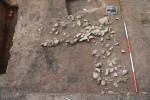 Caligula first sent Legio XXII to Germany in 39 A.D. It garrisoned the fort in Mainz (Mogontiacum) which was one of a series of forts charged with guarding the Rhine border of the Roman province of Germania Superior. The fort in Gernsheim was also part of the Limes Germanicus, and served as a strategically significance launching pad for missions east of the Rhine. Its central location between two important Roman cities — Mainz 30 miles to the northwest and Ladenburg 30 miles south — made it an important link in the infrastructure chain. The cohort (500 soldiers) of Legio XXII was stationed at Gernsheim between 70/80 and 110/120 A.D.
Caligula first sent Legio XXII to Germany in 39 A.D. It garrisoned the fort in Mainz (Mogontiacum) which was one of a series of forts charged with guarding the Rhine border of the Roman province of Germania Superior. The fort in Gernsheim was also part of the Limes Germanicus, and served as a strategically significance launching pad for missions east of the Rhine. Its central location between two important Roman cities — Mainz 30 miles to the northwest and Ladenburg 30 miles south — made it an important link in the infrastructure chain. The cohort (500 soldiers) of Legio XXII was stationed at Gernsheim between 70/80 and 110/120 A.D.
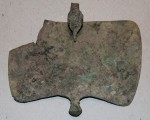 Another artifact found suggests a cavalry presence in the fort as well. It’s a large (about five inches wide by three inches high) bronze pendant that Roman cavalry used to decorate their horses’ harnesses. The pendant indicates that there was a mounted squadron (cohors equitata) attached to the cohort or maybe even a pure cavalry unit (ala) at the Gernsheimer fort.
Another artifact found suggests a cavalry presence in the fort as well. It’s a large (about five inches wide by three inches high) bronze pendant that Roman cavalry used to decorate their horses’ harnesses. The pendant indicates that there was a mounted squadron (cohors equitata) attached to the cohort or maybe even a pure cavalry unit (ala) at the Gernsheimer fort.
I like the paper taped to the shovel in the pic reading “Please don’t feed the students” in Deutsch!
The sign appears to be draped over a wire coat hanger hung from the shovel handle. The hanger is surely not from the dig, though I can imagine future archaologists at a 20th century site baffled by the oddly shaped rust stains in the soil.